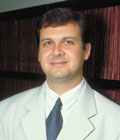University of Houston chemical engineer Peter Vekilov has disproved the applicability of existing theories explaining how and why proteins and other small molecules congeal into solids while dissolved in water, their natural state.
Vekilov's findings are reported today in the journal Proceedings of the National Academy of Sciences of the United States of America. His paper, "Diffusion-limited kinetics of the solution-solid phase transition of molecular substances," reveals that previously accepted theories involving transition-state kinetics are not followed by broad classes of substances, and that the only force driving the transition is the naturally occurring random movement of surrounding water molecules and their impact as they carom into the proteins or other small molecules in question.
The discovery provides researchers of various protein condensation diseases, such as diabetes II, Alzheimer's, Parkinson's and Huntington's Disease, with a valuable insight into the fundamental molecular mechanisms of the critical aggregation process that leads ultimately to the symptoms of those diseases.
"The mechanisms of solution-solid phase transitions hold true for a cluster of diseases, most of which are neurological disorders," says Vekilov, an associate professor of chemical engineering at the UH Cullen College of Engineering. "We hope our findings will provide insight to those in search of new ideas and methods of treatment."
Vekilov's experiments focused on two protein molecules, ferritin and apoferritin, which have identical shapes but different masses. Using an atomic force microscope, Vekilov and his co-authors Dimiter N. Petsev, Kai Chen and Olga Gliko observed identical rates of crystallization for the two proteins. That finding rules out the previously accepted notion that solution-solid phase transitions are driven by transition-state kinetics, says Vekilov.
"If this phase transition follows Einstein's law of Brownian diffusion, as we predicted," Vekilov says, "the mass and velocity of the protein molecules should have no effect on the rate coefficients. And this is precisely what we observed. The rates were identical despite a significant difference in mass and velocity between ferritin and apoferritin."
Vekilov's research was funded by grants from the Office of Biological and Physical Research, National Aeronautics and Space Administration, and the National Lung, Heart, and Blood Institute, National Institutes of Health.
